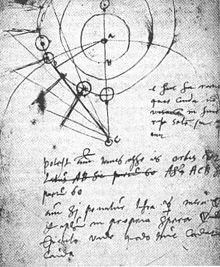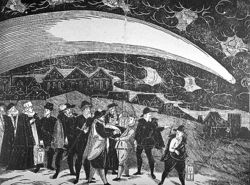- Great Comet of 1577
-
 Tycho Brahe
Tycho Brahe
The Great Comet of 1577 (official designation: C/1577 V1) was a comet that passed close to Earth during the year 1577 AD. It was viewed by people all over Europe, including famous Danish astronomer Tycho Brahe. From his observations of the comet, Brahe was able to discover that comets and similar objects travel above the Earth's atmosphere.[1] The most recent intelligence suggests that the comet is currently about 300 AU from the Sun (24 of Brahe's observations spanning 74 days from 13 November 1577 to 26 January 1578 used for this estimate).[2][3]
Contents
Observations by Brahe and others
Tycho Brahe, who is said to have first viewed the comet slightly before sunset on November 13[4] after having returned from a day of fishing,[5] was the most distinguished observer and documenter of the comet's passing.
Sketches found in one of Brahe's notebooks seem to indicate that the comet may have travelled close to Venus. These sketches depict the Earth at the centre of the solar system, with the sun and moon in orbit and the other planets revolving around the Sun, a model that has since been displaced by heliocentricity.[1]
Despite these misconceptions on Brahe's part, Brahe left behind thousands of very precise measurements he made of the comet's path, and these findings contributed to Johannes Kepler's theorising of the laws of planetary motion and realisation that the planets moved in elliptical orbits.[6] Kepler, who was a student of Brahe's, believed that the comet's behavior and existence was proof enough to displace the theory of celestial spheres, although this view turned out to be overly optimistic about the pace of change.[7]
Brahe's discovery that the comet's coma faced away from the sun was also significant.
One failing Brahe had in his measurements was in exactly how far out of the atmosphere the comet was, and he was unable to supply meaningful figures for this distance;[8] however, he was, at least, successful in proving that the comet was beyond the orbit of the moon about the Earth,[5] and, further to this, was probably around three times further away.[9] He did this by comparing the position of the comet in the night sky where he observed it (Hveen near Copenhagen) with the position observed by an unknown astronomer in Prague at the same time, giving deliberate consideration to the movement of the Moon. It was discovered that, while the comet was in approximately the same place for both of them, the Moon was not, and this meant that the comet was much further out.[10]
Brahe's finding that comets were heavenly objects, while widely accepted, was the cause of a great deal of debate up until and during the seventeenth century, with many theories circulating within the astronomical community. Galileo claimed that comets were optical phenomena, and that this made their parallaxes impossible to measure. However, his hypothesis was not widely accepted.[8]
Five[citation needed] other observers[11] of the comet — Taqi_al-Din Muhammad ibn Ma'ruf[12] Helisaeus Roeslin; William IV, Landgrave of Hesse-Kassel;[citation needed]; Cornelius Gemma;[citation needed] and Michael Mästlin[citation needed] — also identified it as superlunary. The most complex of the early representations of the comet, described as "an interesting, though crude, attempt," may have been that of Roeslin.[13]
In art and literature
The literature resulting from the passing of the comet was prolific, and these works, as well as the ideas presented by many astronomers, caused much controversy. However, the idea that comets were heavenly objects became a respected theory, and many took this concept to be true.[8] Artwork inspired by the event was also made—artist Jiri Daschitzky made an engraving that was inspired by the passing of the comet over Prague on November 12, 1577.
Contemporary references
In Ireland, the Great Comet was observed, and an account of its passing was later inserted in the Annals of the Four Masters:
- A wonderful star appeared in the south-east in the first month of winter: it had a curved bow-like tail, resembling bright lightning, the brilliancy of which illuminated the earth around, and the firmament above. This star was seen in every part of the west of Europe, and it was wondered at by all universally.
Notes
- ^ a b "The comet of 1577". http://www.rundetaarn.dk/engelsk/observatorium/komet.htm. Retrieved 25 March 2007.
- ^ NASA. JPL Small-body database browser plot and approximate distance. (needs Java)
- ^ NASA. JPL HORIZONS current ephemeris more accurate position, no plot.
- ^ Seargent, p.105
- ^ a b Grant, p.305
- ^ Gilster, p.100
- ^ Seargent, p. 107
- ^ a b c "The Galileo Project". http://galileo.rice.edu/sci/observations/comets.html. Retrieved 25 March 2007.
- ^ Seargent, p.107
- ^ Lang, p.240
- ^ Moritz Valentin Steinmetz: Von dem Cometen welcher im November des 1577. Jars erstlich erschienen, und noch am Himmel zusehen ist, wie er von Abend und Mittag, gegen Morgen und Mitternacht zu, seinen Fortgang gehabt, Observirt und beschrieben in Leipzig ..., Gedruckt bey Nickel Nerlich Formschneider, 1577 [1]
- ^ Ünver, Ahmet Süheyl (1985). İstanbul Rasathanesi. Atatürk Kültür, Dil ve Tarih Yüksek Kurumu Türk Tarih Kurumu yayınları. pp. 3–6.[2]
- ^ Robert S. Westman, "The Comet and the Cosmos: Kepler, Mästlin, and the Copernican Hypothesis," in The Reception of Copernicus' Heliocentric Theory: Proceedings of a Symposium Organized by the Nicolas Copernicus Committee of the International Union of the History and Philosophy of Science, Torun, Poland, 1973 (Springer, 1973), pp. 10 and 28. For a description and reproduction of Helisaeus Roeslin's diagram, see pp. 28–29 online.
References
- Seargent, David (2009). The Greatest Comets in History. Springer. ISBN 0387095128.
- R. Lang, Kenneth; Charles Allen Whitney (1991). Wanderers in Space. CUP Archive. pp. 240. ISBN 0521422523.
- Gilster, Paul (2004). Centauri Dreams. Springer. pp. 100. ISBN 038700436X.
- Grant, Robert. History of Physical Astronomy, from the Earliest Ages to the Middle of the 19th Century. R. Baldwin, 1852. pp. 305.
Categories:- 1577
- Comets
- 1577 in science
Wikimedia Foundation. 2010.


